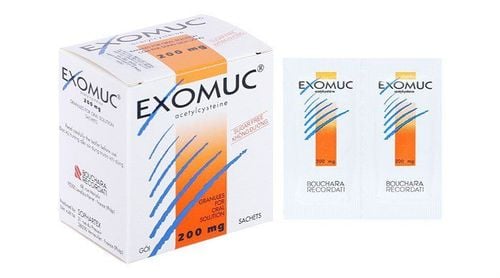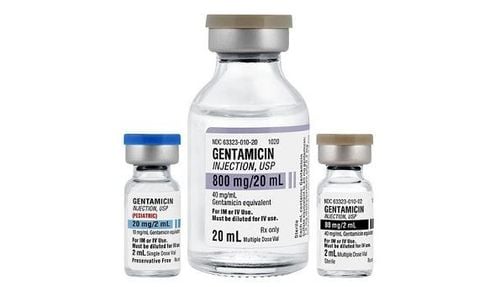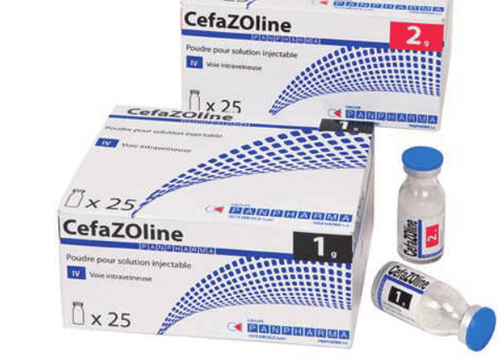This is an automatically translated article.
Clyodas is an antibiotic belonging to the Lincosamide group, with the main effect of treating severe infections caused by anaerobic bacteria caused by Bacteroides fragilis, or Gram-positive bacteria such as Streptococci, such as bronchopneumonia, bacteremia, and sores. festering wounds, ... So to find out specifically what drug Clyodas is? Let's find out the necessary information about the use of Clyodas drug through the article below.
1. What are the effects of Clyodas?
1.1. What is Clyodas? The drug Clyodas belongs to the pharmacological group: Lincosamides, which is a group of drugs that treat parasites, anti-infectives, antivirals and antifungals. Clyodas 300 is indicated for the treatment of infections caused by bacteria sensitive to clindamycin such as Bacteroides fragilis and Staphylococcus aureus, especially in patients who are usually allergic to penicillin-containing ingredients.
Clyodas 300 medicine has ingredients: Clindamycin (in the form of clindamycin HCl) 300mg.
1.2. Clyodas drug use Clyodas drug is a lincosamide antibiotic it has bacteriostatic effect, mainly against Gram-positive bacteria and many types of anaerobic bacteria. The effect of clindamycin is mainly bacteriostatic, although at high concentrations it can be slow bactericidal against susceptible strains.
Indications:
Treatment of severe infections caused by anaerobic bacteria, especially Bacteroides fragilis. Clindamycin is also used in the treatment of infections caused by Gram-positive bacteria such as Streptococci (including methicillin-resistant strains) and Pneumococci.
Treatment of infections caused by susceptible bacteria in the following cases: ENT caused by penicillin-resistant S.pneumoniae, bronchopneumonia, maxillofacial, skin, acne, genitals, bones and joints, bacterial infections bleeding (except meningitis). Intra-abdominal infections such as peritonitis and intra-abdominal abscesses; purulent wound infection. Febrile (genital tract), severe infections of the pelvic area and female genital tract. eye trauma, endophthalmitis. Gastric gangrene infection. Prophylaxis: Infectious intracardiac meningitis during dental procedures, respiratory tract in case of allergy to beta-lactams. In addition, clindamycin is also combined with oral quinine to treat chloroquine-resistant malaria; and primaquine for the treatment of Pneumocystis jiroveci pneumonia; with pyrimethamine for the treatment of Toxoplasmosis.
Multi-drug regimen for the treatment of anthrax caused by inhalation of anthrax spores, severe cutaneous anthrax.
2. How to use Clyodas
2.1. How to take Clyodas How to take the drug by mouth: Patients can take the drug with or without food, should drink with plenty of water to avoid irritation. How to use for injections: Reconstitute the medicine with the solvent with the whole vial of the powder. The drug is administered by intramuscular injection either intravenously or by intravenous infusion.
The duration of treatment with the dose of clindamycin depends on the type of infection, the severity of the disease with the patient. In infections caused by group A hemolytic beta streptococci, clindamycin treatment should be continued for at least 10 days. In severe infections such as endocarditis or osteomyelitis, treatment is required for at least 6 weeks.
The drug is injected intramuscularly or intravenously intermittently or continuously with a diluent not to exceed 12 mg per ml, at a rate not exceeding 30 mg per minute. No more than 1.2 g should be injected intravenously in 1 hour, nor more than 600 mg should be injected intramuscularly at a time.
2.2. Dosage of Clyodas Oral Tablets Adults:
The usual dose is 150 – 450 mg (1 – 3 tablets) every 6 hours, depending on the severity of the infection.
Elderly:
Dosage requirements in the elderly are not influenced by age alone.
Children:
The usual dose is 3 – 6 mg per kg, every 6 hours depending on the severity of the infection. Do not exceed the adult dose.
Clyodas® 150 hard capsules are not suitable for children who are unable to swallow whole tablets. Capsules do not provide an exact dose of mg/kg, so an alternative dosage form is needed in some cases.
Renal impairment:
No dose adjustment is required in patients with mild to moderate renal impairment. In patients with severe renal impairment or anuria, plasma concentrations should be monitored. Based on the results, this measurement can reduce the dose or increase the dose interval to 8 hours or even 12 hours if needed.
Hepatic impairment:
In patients with moderate to severe hepatic impairment, the half-life of clindamycin is prolonged. Dose reduction is generally not required if clindamycin is given every 8 hours. However, plasma concentrations of clindamycin should be monitored in patients with severe hepatic impairment. Based on the results, this measurement can lead to a dose reduction or an increase in dose interval if necessary.
The duration of treatment with clindamycin depends on the type of infection and the severity of the disease. In infections caused by group A beta-hemolytic Streptococcus, clindamycin treatment must be continued for at least 10 days. In severe infections such as endocarditis or osteomyelitis, treatment is required for at least 6 weeks.
Dosage for injection:
Dosage is expressed in terms of quantity equivalent to clindamycin.
Injury to the eye: Intravenous gentamicin 1.5 mg/kg plus clindamycin 600 mg. Gaseous gangrene in penicillin-sensitive patients: Clindamycin 600 mg IV every 8 hours. Aspiration pneumonia: Slow intravenous injection of 600 mg clindamycin, every 8 hours. Children: The dose of clindamycin injected intramuscularly or intravenously for children over 1 month of age, usually from 15-40g/kg in a day, divided into 3-4 times. The dose for intramuscular or intravenous injection for infants under 1 month of age is 15-20 mg/kg in a day, divided into 3-4 times. For premature infants, 15 mg/kg per day may be appropriate. Patients with renal and hepatic impairment: The dose of clindamycin should be reduced in patients with severe hepatic and renal impairment; no dose adjustment is necessary in mild to moderate renal impairment and liver disease. Elderly: The half-life, volume of distribution, clearance and extent of absorption following injection of clindamycin phosphate were not altered by increasing age. Analysis of data from clinical studies did not show an association between age and drug toxicity. Therefore, no dose adjustment is required in elderly patients. Handling missed dose: Take that dose as soon as you remember. Treatment of overdose: When there is an overdose, it is necessary to immediately notify the treating doctor and take the patient to the hospital for timely treatment.
3. Contraindications of the drug Clyodas
History of hypersensitivity to preparations containing clindamycin or lincomycin, focal enteritis or ulcerative colitis, or antibiotic-associated colitis.Clindamycin potentiates the effects of other neuromuscular blocking agents and should be used with caution when co-administered with these drugs.
Patients should not be used concurrently with drugs containing erythromycin because it can inhibit the effect of each other by acting on the same site on the bacterial ribosome.
Vitamin K Antagonists: An increase in blood clotting time (in PT/INR tests) and/or bleeding has been reported in patients treated with a combination of clindamycin and a vitamin K antagonist (eg, warfarin). , acenocoumarol and fluindione). Therefore, coagulation tests should be regularly monitored in patients treated with vitamin K antagonists.
4. Notes when using the drug Clyodas
Caution when using the drug for:
Patients with gastrointestinal disease or a history of colitis. Elderly patients are particularly sensitive to the drug. Clindamycin accumulates in patients with severe hepatic impairment, therefore dosage adjustment and periodic analysis of liver enzymes are required in these patients.
Caution:
Causes pseudomembranous colitis due to C.difficile. With caution in people with gastrointestinal disease or a history of colitis. Elderly patients are particularly susceptible to the drug, requiring careful monitoring of bowel movements and diarrhea. Clindamycin accumulates in patients with severe hepatic impairment. Using clindamycin may overgrow bacteria that are not sensitive to the drug. It is essential to monitor the patient and make regular antibiotic charts for appropriate treatment. Clindamycin should be used with caution in patients with severe renal and hepatic impairment. When using high doses in this patient, serum concentrations of clindamycin should be monitored. Children under 16 years of age when taking the drug should regularly monitor the function of the organs in the body. Do not use the drug to treat infections of the central nervous system. The drug does not cross the blood-brain barrier, so it is not used for meningitis. Clindamycin is poorly tolerated in patients with AIDS. Clindamycin is not safe for patients with porphyria and should be avoided in patients with acute porphyria. Anaphylactic reaction. Patients with severe diarrhea should not take this medicine. Fertility, pregnancy and lactation
Pregnancy
Clindamycin crosses the human placenta. After multiple doses, amniotic fluid concentrations are approximately 30% of maternal blood concentrations. Clindamycin should be used during pregnancy only when clearly needed. Lactation
Clindamycin is excreted in breast milk. Oral and parenteral clindamycin has been reported to appear in breast milk between 0.7 and 3.8 μg/ml. Because of the potential for serious adverse reactions in a nursing infant, clindamycin should not be administered to a nursing mother. Fertility
In animal studies, clindamycin did not affect fertility or mating
5. Side effects of the drug Clyodas
Infection or parasitic infection:
Common: Colitis Not known: vaginal infection or colitis due to clostridium difficile. Blood or lymphatic vessel disorders:
Common: Eosinophilia. Not known: agranulocytosis, neutropenia, thrombocytopenia and leukopenia. Immune system disorders:
Not known: anaphylaxis, anaphylactoid reactions, anaphylactic reactions, hypersensitivity. Nervous system disorders:
Uncommon: Taste disturbance. Cardiac disorders:
Uncommon: Cardiac-respiratory arrest. Vascular disorders:
Common: thrombophlebitis. Uncommon: decrease in blood pressure. Digestive system disorders:
Common: diarrhea. Uncommon: abdominal pain, nausea, vomiting. Not known: esophagitis, esophageal ulcer. Hepatobiliary disorders:
Not known: jaundice. Skin and subcutaneous tissue disorders:
Common: maculopapular rash. Uncommon: urticaria. Rare: erythema multiforme, pruritus. Not known: toxic epidermal necrolysis (TEN), Stevens–Johnson syndrome (SJS), drug reaction with eosinophilia and systemic symptoms (DRESS), acute generalized pustular rash (AGEP), angioedema, dermatitis, exfoliative, bullous dermatitis, measles-like rash. General disorders and administration site:
Uncommon: pain, abscess at injection site. Not known: discomfort at the injection site. Test/laboratory results:
Common: abnormal liver function test.
6. How to store Clyodas
Store in a cool, dry place, at a temperature not exceeding 30°C, in the original packaging and protected from light. Keep out of reach of CHILDREN. Expiry date: 36 months from date of manufacture.
Please dial HOTLINE for more information or register for an appointment HERE. Download MyVinmec app to make appointments faster and to manage your bookings easily.













